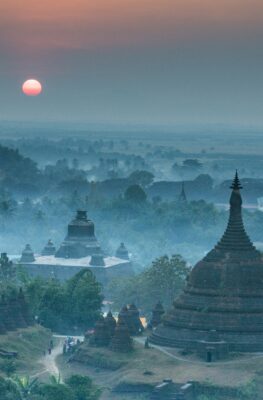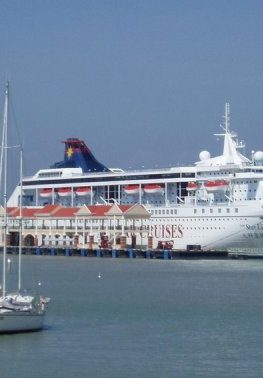Published on May 29, 2015
Although to date, in their 42 years’ history UNESCO recognized more than 1,000 cultural and natural sites as “World Heritage Sites” (WHS), the process to become one is long and stringent. A prerequisite for a site to be included is that only countries that are signatory to the World Heritage Convention can submit nomination proposals for territorial sites to be considered for inscription on UNESCO’s World Heritage List. Next, a country has to submit a Tentative List of important heritages on its territory; select sites from this list and prepare an exhaustive Nomination File for each, including necessary documentation and maps. Every site has to be of outstanding universal value and meet at least one out of ten selection criteria.
It therefore won’t come as a surprise that the whole process from tentative listing to nomination, and evaluation to approval and inscription, could easily cover 5 years or more, especially since many of UN member states lack sufficient time, expertise and funds to complete a nomination file or have more pressing socio-economic and political priorities. This, for instance explains why 3 of Myanmar’s top tourist destinations, Bagan, Inle Lake, and the Ancient City of Mandala already feature on the Tentative List since 1996, without having made it to a Nomination. Fortunately however, the country received recognition for another historic site of great distinction, “Pyu Ancient Cities”, in 2014.

Ruins of Sri Ksetra, the largest of the cities built by the Pyu people;
Source: http://www.timetravelturtle.com/2013/02/pyu-city-sri-kestra-pyay- myanmar/
A groups known as the Pyu, possibly from the Tibetan-Burman plateau or from India, created three city-states in central Myanmar at Beikthano, Halin and Thayekhittaya (Sri Ksetra) somewhere between 200 BC an AD 900. They echo the Pyu Kingdoms that thrived for over 1,000 years. The Pyu Ancient Cities site includes the remains of these three stone cities, enclosed by walls and ditches.
Their civilizations stretched north to south for hundreds of kilometers on vast wetted landscapes along the Ayeyarwady (Irrawaddy) River, developed by advanced irrigation techniques.
The three cities are partly dig up archaeological sites. Remnants include unearthed forts, funeral grounds and manufacturing sites, as well as enormous brick Buddhist stupas and water management features, some still in use.
Although little is known about the Pyu, the art and architecture they left behind indicate they had their own alphabet and practiced Buddhism mixed with Hinduism. Buddhism achieved its first permanent foothold in Southeast Asia among the Pyu cities, where it was embraced by all classes of society.
The development of Pyu Buddhist urban culture had widespread and enduring impact on mainland South East Asia, following the onward transmission of Buddhist teaching and monastic practice into other parts of the region.

Myanmar map with location of Pyu Cities; Source: http://globalsecurity.org
THE PHILIPPINES
The Philippines are blessed with six World Heritage Sites, three natural:
- “Tubbataha Reefs Natural Park”
- “Puerto-Princessa Subterranean River National Park”
- “Mount Hamiguitan Range Wildlife Sanctuary”
And three cultural:
- “The Historic Town of Vigan”
- “The Rice Terraces of the Cordilleras”
“The Baroque Churches of the Philippines”

Pictorial Medley of the 6 Philippine World Heritage Sites; Source: http:/tourorganizers.blogspot.com/
Just like Myanmar’s map clearly shows vast distances between the multiple-locations of the Ancient Pyu Cities, so is Philippines World Heritage Site “Baroque Churches” covering a lot of ground.
“The Baroque Churches of the Philippines” WHS is a multiple-location inscription consisting of four Roman Catholic churches constructed between the 16thand the18th centuries during the Spanish period of the Philippines. They are located in different areas of the archipelago, two at the northern island of Luzon (Paoay and Santa Maria), one in the capital Manila, and the other on the central Visayas island of Iloilo (Miagao).
The churches have a style of constructing and design in common, adjusted to the physical conditions of the Philippines (e.g. tropical, typhoons, and earthquakes) that had vital influence on later regional church architecture. In addition they share qualities like their monumental, immense appearance, illustrating a castle-like disposition in reaction to pirates and bandits. The four churches are outstanding examples of the Philippine interpretation of the Baroque style, representing a fusion of European church design and construction with local materials and ornamental styles to create a new church-building practice.

The San Augustin Church, Manila; one of the four Baroque churches declared World Heritage
Source: http://weddinginthephilippines.com
The Miag-ao Church at Iloilo (see picture) is a prime example of these characteristics. After the looting and burning down by pirates of two earlier versions, the people of Miagao were discouraged from building another church. But they needed one, not only as a house of worship but also as a stronghold against pirate attacks. So, some 50 years after the first attack, they decided to build a third church in Tacas, where the townsfolk had a controlling view of the mouth of the Miagao river, the usual route followed by the pirates upon entering the town.

Miagao Church, Iloilo, one of the 4 Baroque Churches that form one WHS; Source: http://balintataw.org
Monumental Churches spread out over the Philippine Archipelago and
Sturdy Remnants of ancient Cities of a Kingdom in Myanmar,
Defying elements and catastrophes for centuries, while
Proudly justifying their World Heritage Status






